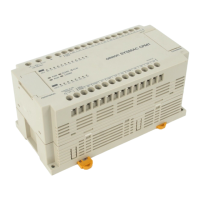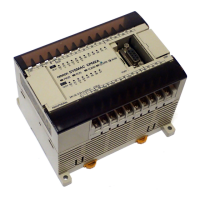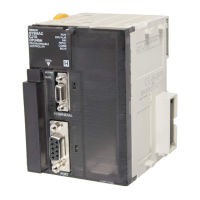456
6-1-4 I/O Refreshing
I/O refreshing refers to the reading of ON/OFF input bit data from Input Units to
I/O memory and the writing of ON/OFF output bit data from I/O memory to Out-
put Units.
CPU, CPU Expansion, and Expansion I/O Racks
The following list shows the five methods for refreshing I/O words allocated to
Units on the CPU, CPU Expansion, and Expansion I/O Racks. The first three
methods refresh all I/O points at once, the fourth refreshes a selected group of
I/O words, and the fifth refreshes only those I/O points affected by an instruction.
1, 2, 3...
1. Cyclic refreshing
2. Scheduled refreshing
3. Zero-cross refreshing
4. IORF(184) refreshing
5. Immediate refreshing
One of the first three refreshing methods must be selected in the PC Setup. The
default method is cyclic refreshing. Immediate and IORF(184) refreshing can be
used in addition to the I/O refreshing method selected in the PC Setup. If all three
methods are disabled by setting scheduled refreshing with an interval of 00, only
Immediate and IORF(184) refreshing will be possible.
Cyclic Refreshing In cyclic refreshing, all I/O points are refreshed once each cycle after the pro-
gram is executed. When SFC programming is not used, I/O points are refreshed
when the program has been executed from the first instruction to END(001); with
SFC programming, I/O points are refreshed when the actions in active steps
have all been executed. Output points are refreshed first, then input points.
Scheduled Refreshing In scheduled refreshing, all I/O points are refreshed at a regular interval preset
between 10 ms and 120 ms in the PC Setup. Scheduled refreshing is only pos-
sible when the PC is set for asynchronous operation. If a scheduled refresh oc-
curs during program execution or interrupt processing, the scheduled refreshing
will not begin until that procedure is completed. Scheduled refreshing can be
stopped by turning ON bit A01705 (the I/O Refresh Disable Bit).
If the interval between refreshes is set to 00, refreshing will be disabled and only
immediate or IORF(184) refreshing will be possible.
Zero-cross Refreshing In zero-cross refreshing, all output points are refreshed when the AC power sup-
ply voltage crosses 0 V, the program is executed next, and then input points are
refreshed. Zero-cross refreshing is for use with output points allocated to Output
Units mounted on a CPU Rack, CPU Expansion Rack, or Expansion I/O Rack.
Zero-cross refreshing has the following advantages, particularly when used with
AC output devices:
1, 2, 3...
1. The voltage supplied to the load is near zero when it is switched ON or OFF,
so surge voltages are not generated.
2. The simultaneous ON time for devices such as solenoids operating against
each other can be reduced and coil burning can be prevented.
Use a commercial power supply with a sine-wave output.
PC Operation Section 6-1

